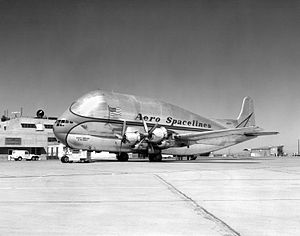Aero Spacelines Pregnant Guppy
| Pregnant Guppy | |
|---|---|
 |
|
| The Pregnant Guppy at the Dryden Flight Research Center for testing and evaluation (October 1962) | |
| Role | Outsize cargo freight aircraft |
| Manufacturer | Aero Spacelines |
| First flight | September 19, 1962 |
| Retired | 1979 |
| Status | Scrapped |
| Primary users |
Aero Spacelines NASA |
| Produced | 1 |
| Developed from | |
| Developed into | Aero Spacelines Super Guppy |
The Aero Spacelines Pregnant Guppy was a large, wide-bodied cargo aircraft built in the United States and used for ferrying outsized cargo items, most notably NASA's components of the Apollo program. The Pregnant Guppy was the first of the Guppy line of aircraft produced by Aero Spacelines. The design also inspired similar designs such as the jet-powered Airbus Beluga, and the Boeing Dreamlifter.
In 1960, U.S. airlines were disposing of their obsolete piston-engined in favor of the newer jet-engined airliners. NASA was finding that barge transport of their increasingly large space program components from manufacturers on the West Coast to test and launch sites on the East Coast was slow and expensive. Aircraft broker Leo Mansdorf was stockpiling surplus Stratocruisers at Van Nuys prior to resale, and ex-USAF pilot John M. Conroy realized the potential of these aircraft to transport the large but relatively light rocket components.
Conroy presented his plans for an extensively modified Stratocruiser to NASA, where an official commented that the bloated aircraft resembled a pregnant guppy. Although NASA was lukewarm on the concept, Conroy mortgaged his house and founded Aero Spacelines International in order to build and operate the concept aircraft.
Conversion work was undertaken by On Mark Engineering. The Pregnant Guppy (registered N1024V) was built from an ex-Pan Am airframe with a five-meter section from an ex-British Overseas Airways Corporation aircraft (G-AKGJ) added immediately behind the wing. The wing, engines, tail, nose and cockpit were unchanged, but a new upper fuselage of six meters diameter was added, giving the aircraft a "triple-bubble" appearance in front view. The entire rear section (including tail surfaces) was detachable to allow cargo to be loaded directly into the fuselage.
...
Wikipedia
